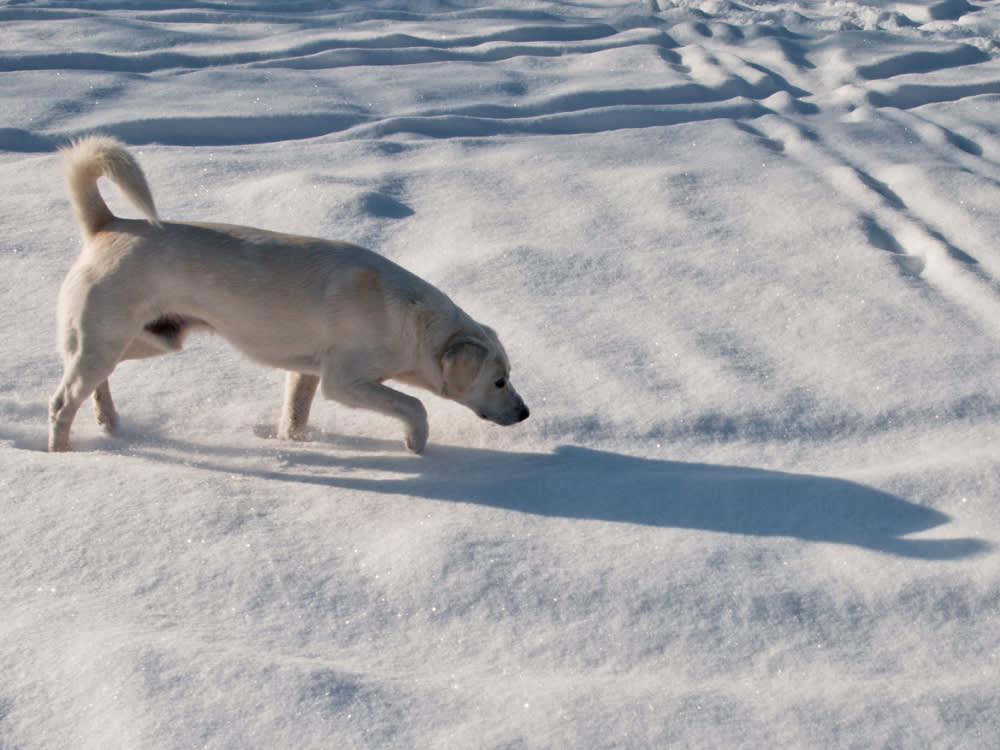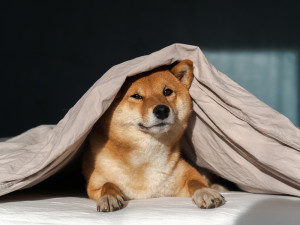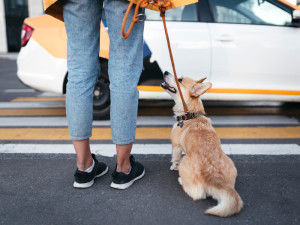“Why Is My Dog Obsessed With Chasing Shadows?”
A fascination with lights and shadows is common in high-energy dogs — but it can develop into obsessive-compulsive disorder if it gets out of hand.

Share Article
My 1 1/2-year-old neutered male English Shepherd developed a fascination with light and shadows about nine months ago. He chases any reflections he sees, and on cloudy days, he does the chasing behavior in places where shadows usually appear. He will stand outside under a tree and watch shadows of leaves blowing for 20 minutes at a time. He is an inside/outside dog and gets at least an hour walk each day. The behavior is not destructive, but I worry about the total attention he gives to it, and I don’t want it to get worse. Why does my dog chase shadows, and what should I do?
A fascination with lights and shadows is most common in high-energy, high-drive dogs, and most of the cases I’ve seen have been in herding or hunting breeds who have come from working lines. As in your dog’s case, it often shows up in adolescence. You're right to be concerned because this problem seems to escalate if left to its own devices, and I worry that it may already be affecting your dog’s quality of life.
Many dogs who start with a little chasing of shadows can degenerate into cases of full-blown obsessive-compulsive disorder. If that happens, additional compulsive behaviors may develop. Because of the potentially serious nature of this problem, it is worth having your dog evaluated by a veterinary behaviorist in your area who understands anxiety disorders. Also, a change in diet sometimes helps dramatically and is worth a try.
Prevention is a critical part of helping to extinguish the behavior, so whenever possible, keep your dog out of situations that elicit it. Obviously, you cannot eliminate lights and shadows from your dog’s life, but even simple steps such as hanging dark curtains, spending time with your dog in the rooms with the fewest lights and shadows, and temporarily storing particularly reflective items can help.

Your response when your dog begins to chase light or fixate on shadows will have a big impact on his behavior. Let your motto be: Interrupt and redirect, but never punish. Interrupt the behavior and try to redirect him to some other sort of behavior. Try to distract him with a favorite toy or use a new squeaky toy to get his attention. Consider rattling his leash and heading out for a walk if that works to distracts him. (Don’t do this last one too often or he may learn to chase shadows in order to get you to take him out.)
The interruption should distract your dog, but should never scare him. Good options for redirection include tug, fetch, the ever-popular frozen Kong, a chew toy, outdoor exercise, or a training session. It can be tempting to respond in a negative way to this behavior, but any punishment carries the risk of making the behavior worse.
An hour walk each day is enough for many dogs, but additional exercise for a young, active dog so interested in light and shadows is really important. Off-leash running for an hour or more a day (or better yet, twice a day) can really make a big difference, as can tiring activities such as fetch and swimming. I realize that finding safe places to do this is often the biggest challenge. Physical exercise can greatly help this problem, but so can additional mental exercise. Giving your dog’s mind more to do may help as much as the physical exercise. Give him enrichment toys that tax his brain, teach him tricks daily, or attend classes.
If you feel that your dog's light obsession is worsening or is more noticeably affecting the quality of his life (or yours!), consider talking to a qualified veterinarian about medicine for obsessive-compulsive behavior and trying complementary medical therapy such as Chinese medicine or homeopathy.

Karen B. London, PhD, CAAB, CPDT-KA
Karen B. London is a certified applied animal behaviorist (CAAB) and certified professional dog trainer (CPDT) who specializes in working with dogs with serious behavioral issues, including aggression. She has written for a variety of magazines including The Bark, Clean Run, and the APDT Chronicle of the Dog, and has published in scientific journals including Behavioral Ecology and Sociobiology, Ethology, Ecology, and Evolution, the Journal of Insect Behavior, and Insectes Sociaux. She is the author of seven books about dog training and canine behavior, including the forthcoming My Dog's Mystery Adventure: And Other Stories From a Canine Behaviorist and Dog Trainer.
Related articles
![A vet holding medicine near a dogs face]()
How to Find a Veterinary Specialist
Just like your doctor would refer to you a specialist for expert care for a complicated issue, your vet may do the same for your dog.
![Shiba Inu dog under a blanket, burrowing in covers]()
Why Dogs Burrow Under the Covers (And Dig In the Bed)
What’s behind the desire and whether it’s safe to do.
![Dog looks up at owner on a walk through the city]()
7 Ways to Stop Your Dog from Scavenging on Walks
If your dog tries to scarf down literally everything in sight, you need this advice.
![Dog looking towards the sky on an op-art background]()
Animal Instincts: Entering the Realm of Pet Psychics
Animal communicators in NYC and LA illuminate us on what your pets are really thinking.




